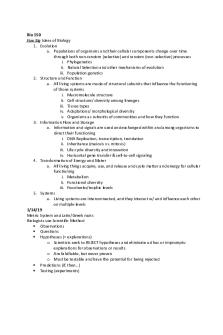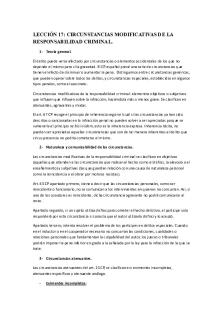Bio 150 - Lecture notes 1-7 PDF

| Title | Bio 150 - Lecture notes 1-7 |
|---|---|
| Course | Biology |
| Institution | The University of Tennessee |
| Pages | 5 |
| File Size | 108.5 KB |
| File Type | |
| Total Downloads | 81 |
| Total Views | 206 |
Summary
All in-class notes for bio 150 with Matheny...
Description
Bio 150 Five Big Ideas of Biology 1. Evolution a. Populations of organisms and their cellular components change over time through both non-random (selective) and random (non-selective) processes i. Phylogenetics ii. Natural Selection and other mechanisms of evolution iii. Population genetics 2. Structure and Function a. All living systems are made of structural subunits that influence the functioning of those systems i. Macromolecule structure ii. Cell structure/ diversity among lineages iii. Tissue types iv. Adaptations/ morphological diversity v. Organisms as subunits of communities and how they function 3. Information Flow and Storage a. Information and signals are used and exchanged within and among organisms to direct their functioning i. DNA Replication, transcription, translation ii. Inheritance (meiosis vs. mitosis) iii. Life cycle diversity and innovation iv. Horizontal gene transfer & cell-to-cell signaling 4. Transformation of Energy and Mater a. All living things acquire, use, and release and cycle matter and energy for cellular functioning i. Metabolism ii. Functional diversity iii. Food webs/trophic levels 5. Systems a. Living systems are interconnected, and they interact w/ and influence each other on multiple levels 1/14/19 Metric System and Latin/Greek roots Biologists use Scientific Method Observations Questions Hypotheses (= explanations) o Scientists seek to REJECT hypotheses and eliminate ad hoc or impromptu explanations for observations or results o Are falsifiable, but never proven o Must be testable and have the potential for being rejected Predictions (if, then…) Testing (experiments)
Theories- hypotheses that have withstood countless attempts of falsification Ex: Evolution via natural selection Must know if differences between treatments are significant Statistical tests start with the null hypothesis o No significant difference between treatments and an alternative hypothesis Statistical tests eliminate the possibility of observed differences being random REPLICATION Why do giraffes have long necks? Food competition o Long necks are adaptations that increase the fitness of individual giraffes during competition for food o Predicts that: Neck length is variable- correct Neck length is heritable- could not test in natural populations doing breeding experiments Giraffes feed high in trees when food is scarce- most feeding is done at shoulder height Sexual Competition o Males taste urine of females to determine if in estrus or “heat” o Males fight for opportunities to mate Longer necks provide more leverage for harder blows (longer moment arm increased force) Native Pine Beetles destroying forests of Colorado 1/16/19 Hypotheses-state in detail the explanation for a given phenomenon- Provide answer to a question Predictions- specify what we should observe if the hypothesis is supported. Must be testable Experiments- use appropriate controls to eliminate variables, other than that being tested, that may influence the outcome Repetition is necessary to reduce random results Phylogenies and History of Life Darwin- 1st tree Phylogeny- the evolutionary history of a group of organisms Reconstruction of evolutionary relationships of species, genes, or geographic areas Philosophical Underpinnings There is one “True” phylogeny o Goal to reconstruct evolutionary history by phylogenetic interference (educated guess)- cannot say phylogeny constructed is true o Phylogenies are Hypotheses Components Tips, terminals, leafs, taxa (n=#) Branches connected by internodes
Root found by designating an outgroup A Tree is NOT a ladder of progress Sister Groups- two species that are more closely related to each other than to any other species in the tree Share a most recent common ancestor o Ex: Chimps and humans Synapomorphy- shared, derived traits Diagnose CLADES or MONOPHYLETIC groups Positions in DNA sequences also serve as synapomorphies More closely related organisms have more similar DNA sequences The Tree of life Species with more similar DNA sequences cluster together 1/23/19 Different kinds of groups 1. Monophyletic Group a. All descendants from a common ancestor i. Birds (feathers & endothermy) ii. Animals & fungi (opisthokonts) iii. Angiosperms or flowering plants (presents of an enclosed carpel) 2. Polyphyletic Group a. Descendants lack a common ancestor unique to themselves i. Bats and Birds (wings have evolved independently) ii. Truffles iii. Algae 3. Paraphyletic Group a. Include a common ancestor but exclude descendants i. Dinosaurs, Dicots, Fish, Prokaryotes (bacteria & archaea) Shared derived traits (synapomorphies) diagnose monophyletic groups Shared Ancestral traits will result in paraphyletic groups Traits that have evolved independently can indicate polyphyletic groups Homology- similarity in organisms due to common ancestry Homologous traits- Hox genes share similar sequences and same order on chromosomes Homoplasy- similarity in organisms due to reasons other than common ancestry Wings Ancestral trait- existed in ancestor Derived trait- modified form of ancestral trait Synapomorphies- shared derived traits that unite twigs and branches 1/28/19 Phylogenies are Hypotheses SINEs (short interspersed nuclear elements) are short parasitic gene sequences that occasionally insert themselves into the genomes of mammals Dramatic Event that Alter Biological Diversity
Periods when species originate and diversify rapidly: ADAPTIVE RADIATIONS o Ecological opportunity (extrinsic) o Morphological Innovation (intrinsic) Periods when species rapidly go extinct: MASS EXTINCTIONS Criteria to Study Adaptive Radiations 1. Group must be monophyletic 2. Diversification is Rapid (polytomy) 3. Species come to occupy wide ranges of niches How do adaptive radiations occur? 1. New Resources (Ecological Opportunity)- the availability of new or novel types of resources (habitats) 2. Morphological innovations- evolution of a novel trait facilitated diversification and expansion of descendants into new areas or to use new resources in novel ways Mass Extinctions Rapid elimination of many lineages scattered throughout tree of life—random Evolutionary hurricanes o >60% of species are wiped out within one million years Background extinction End-Permian Extinction 251 million years ago Only 10% of Earth’s species survived 50% of all families extinct CO2 up, SO2 up, O2 down, and sea levels down End-Cretaceous Extinction 65 Million years ago 20-40% species survival Dinosaur extinction 1/30/19 Evolutionary Thought 1. Populations and species evolve, individuals DO NOT. a. Evolution is change in allele frequency over time i. Allele- alternative form of a gene 2. Natural Selection acts on individuals. Evolution by natural selection occurs when individuals with certain alleles produce the most surviving offspring in a population. a. An adaptation increases an individuals’ ability to produce offspring in a particular environment 3. Evolution is not progressive. a. Does not alter characteristics of the individual, only of the population Typological Thinking: species are created ‘perfect’, immutable, variation unimportant (Plato and Book of Genesis) Aristotle ordered organisms into a “great chain of being” Species could evolve “up” the great chain over time
Acquired phenotypic changes passed on to offspring Lamarckian Evolution: giraffes develop long necks as the stretch to reach food offspring should have long necks Evolution of Darwin and Wallace: Gradual changes in populations over time (descent with modification) o Species change through time Related by common ancestry o Population Thinking (Scientific) Summary as 4 Postulates 1. Individuals within Species are variable 2. Some of the variation is heritable (passed to offspring) 3. In every generation, more offspring are produced than can survive 4. Survival and reproduction are not random. Those with higher fitness are naturally selected Evidence for Change Through Time Darwin influenced by geologist Charles Lyell; Earth > 300 million yo Per radiometric data: earth is 4.6 billion yo Extinction changes species present over time o Species are not static as 99% have gone extinct Transitional features- link older and younger species Traits in fossil species that are intermediate between an ancestral (older) and a derived (younger) species o Ex: lungfish species to limbs Genetic Homology- gene structure Developmental Homology- embryonic structure Structural Homology- morphological traits in adults...
Similar Free PDFs

ARTS 150 Lecture 17
- 4 Pages

Bio 150 - Lecture notes 1-7
- 5 Pages

2020-BIO 150-lecture notes 3
- 1 Pages

Syllabus Bio 150 lab
- 4 Pages

Bio 150 Keck - Exam 3 Notes
- 13 Pages

LecciÓn 17 - Lecture notes 17
- 6 Pages

Chapter 17 - Lecture notes 17
- 15 Pages

Chapter 17 - Lecture notes 17
- 7 Pages

LEC17 - Lecture notes 17
- 28 Pages

CH17 - Lecture notes 17
- 17 Pages

L18 - Lecture notes 17
- 2 Pages

Tulips - Lecture notes 17
- 3 Pages

17ATOC - Lecture notes 17
- 4 Pages

Lecture notes, Cell Bio
- 3 Pages

Persuasion - Lecture notes 17
- 2 Pages

Lecture Notes 17
- 2 Pages
Popular Institutions
- Tinajero National High School - Annex
- Politeknik Caltex Riau
- Yokohama City University
- SGT University
- University of Al-Qadisiyah
- Divine Word College of Vigan
- Techniek College Rotterdam
- Universidade de Santiago
- Universiti Teknologi MARA Cawangan Johor Kampus Pasir Gudang
- Poltekkes Kemenkes Yogyakarta
- Baguio City National High School
- Colegio san marcos
- preparatoria uno
- Centro de Bachillerato Tecnológico Industrial y de Servicios No. 107
- Dalian Maritime University
- Quang Trung Secondary School
- Colegio Tecnológico en Informática
- Corporación Regional de Educación Superior
- Grupo CEDVA
- Dar Al Uloom University
- Centro de Estudios Preuniversitarios de la Universidad Nacional de Ingeniería
- 上智大学
- Aakash International School, Nuna Majara
- San Felipe Neri Catholic School
- Kang Chiao International School - New Taipei City
- Misamis Occidental National High School
- Institución Educativa Escuela Normal Juan Ladrilleros
- Kolehiyo ng Pantukan
- Batanes State College
- Instituto Continental
- Sekolah Menengah Kejuruan Kesehatan Kaltara (Tarakan)
- Colegio de La Inmaculada Concepcion - Cebu